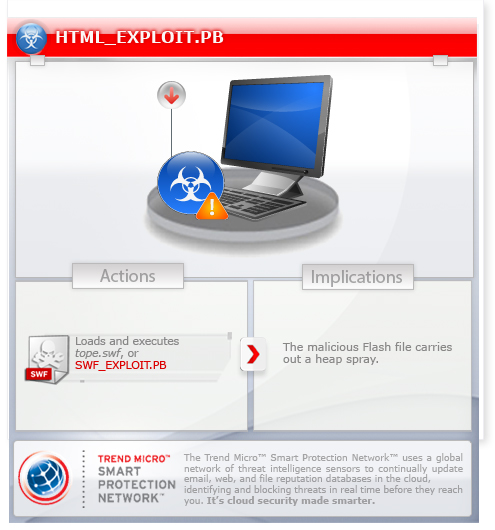HTML_EXPLOIT.PB
Windows 2000, Windows Server 2003, Windows XP (32-bit, 64-bit), Windows Vista (32-bit, 64-bit), Windows 7 (32-bit, 64-bit)


Threat Type: Trojan
Destructiveness: No
Encrypted: No
In the wild: Yes
OVERVIEW
This malicious HTML file is related to the zero-day vulnerability in Internet Explorer 9 and 10, or CVE-2014-0322. The vulnerability makes use of a "hybrid exploit" where the malicious exploit code is split between JavaScript and Adobe Flash.
To get a one-glance comprehensive view of the behavior of this Trojan, refer to the Threat Diagram shown below.

This Trojan executes when a user accesses certain websites where it is hosted.
It is used to load and execute a file. It takes advantage of certain vulnerabilities.
TECHNICAL DETAILS
2,681 bytes
HTML, HTM
Yes
14 Feb 2014
Arrival Details
This Trojan executes when a user accesses certain websites where it is hosted.
Download Routine
This Trojan saves the files it downloads using the following names:
- %User Temp%\sqlrenew.txt
- %User Temp%\stream.exe - detected as BKDR_ZXSHELL.V
(Note: %User Temp% is the current user's Temp folder, which is usually C:\Documents and Settings\{user name}\Local Settings\Temp on Windows 2000, XP, and Server 2003, or C:\Users\{user name}\AppData\Local\Temp on Windows Vista and 7.)
Other Details
This Trojan is used to load and execute the following file:
- tope.swf - detected as SWF_EXPLOIT.PB
It takes advantage of the following vulnerabilities:
SOLUTION
9.700
10.606.02
14 Feb 2014
10.607.00
16 Feb 2014
Step 1
Before doing any scans, Windows XP, Windows Vista, and Windows 7 users must disable System Restore to allow full scanning of their computers.
Step 2
Remove the malware/grayware file dropped/downloaded by HTML_EXPLOIT.PB
Step 3
Close all opened browser windows
Step 4
Scan your computer with your Trend Micro product to delete files detected as HTML_EXPLOIT.PB. If the detected files have already been cleaned, deleted, or quarantined by your Trend Micro product, no further step is required. You may opt to simply delete the quarantined files. Please check this Knowledge Base page for more information.
Step 5
Download and apply these security patches Refrain from using these products until the appropriate patches have been installed. Trend Micro advises users to download critical patches upon release by vendors.
- Upgrade to Internet Explorer 11
- Install Microsoft’s Enhanced Mitigation Experience Toolkit (EMET)
Did this description help? Tell us how we did.
